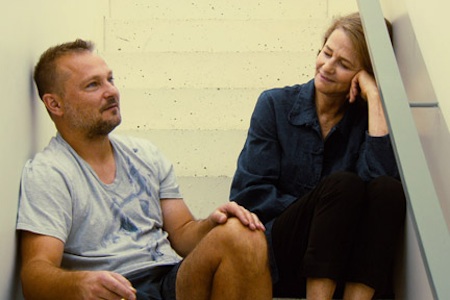“We’re constantly moving, we’re constantly changing. What doesn’t change is that sparkle you find behind someone’s eyes.” So observes the eternally captivating Charlotte Rampling, whose famously heavy lidded stare continues to transfix international auteurs and audiences nearly 50 years into her singular career. That ocular allure is the first of many sensory signifiers we notice in Angelina Maccarone’s tellingly titled documentary, a seductive “self-portrait through others” in which the ravishing Rampling presents, manipulates, refutes and ultimately basks in “the look,” her own and that of the camera. Opening with a close-up of her beguiling visage—more than a little intimidating, and defiantly unsullied by plastic surgery despite the nip-tuck urgings of age-defying peers—Maccarone zooms in on Rampling’s eyes as Calexico’s slinky “Sprawl” sets a tone of effortless cool and playful exoticism on the soundtrack that characterizes this unusually intelligent study of the all-seeing actress who insists, “You cannot watch yourself dispassionately.”
Indeed, who could gaze at Rampling with anything other than passion, whether desirous of what she terms “the erotic, sensual component of exposure” or zealous for her wonderfully idiosyncratic filmography? From her uncredited debut as a water skier in Richard Lester’s 1965 mods-and-rockers knockabout The Knack…and How to Get It through pivotal roles in Georgy Girl, Zardoz and The Verdict to memorable collaborations with François Ozon (Swimming Pool, Under the Sand) and Lars von Trier (Melancholia), Rampling has imbued dozens of movies with her world-weary chic and fearless commitment to often troubled characters. Her dalliance with former SS officer Dirk Bogard in The Night Porter and monkey business with a chimpanzee in Max Mon Amour stand out as particularly brave performances.

Rampling ruminates on many of these pivotal roles in Maccarone’s fond portrait, structured as a series of conversations between the actress and her famous pals (including writer Paul Auster and photographer Juergen Teller) as they lounge in elegantly minimal interiors or stroll the boulevards of London, Paris and New York. Enviously cosmopolitan, still gorgeous in her mid-60s, Rampling doesn’t give a damn if “people think I’m a monster”—she reveals much of herself to her friends, ever-present documentary crew and anonymous viewers alike, yet stays within her own comfort zone. She’s a bit of a tease, and quite possibly dangerous in the way that we can’t be sure when she’s acting and when she’s not. All of which makes her that much more watchable.
Never more so than in this scene (above), placed within a section of the doc titled “Exposure” (other segments include “Beauty,” “Taboo,” “Desire,” “Death” and “Love”). As Rampling and fashion photographer Peter Lindbergh reminisce over a sheaf of glossy shots taken decades earlier, she talks of her simultaneous exhilaration and discomfort in front of the camera, her reliance on animal instinct in the midst of anything-goes takes, and the balancing act of retaining a strong sense of self-identity even while giving herself over completely to a photographer’s lens or director’s vision.
She’s a bit of a tease, and quite possibly dangerous in the way that we can’t be sure when she’s acting and when she’s not. All of which makes her that much more watchable.
Enter The Woodman, playing film director Sandy Bates in Woody Allen’s divisive 1980 Fellini homage Stardust Memories. “I’m crazy about you. You’re incredibly beautiful, whoever you are,” Sandy gushes to Dorrie (Rampling) upon spotting her on set, an extra awaiting her one-line walk-on. Sandy moves closer, Allen’s camera pulls in, and Rampling does that thing with her eyes and voice and distinctive line readings…Sandy, Woody and enthralled viewers are all goners, even more so when Dorrie boasts, “[I’m] fascinating, but I’m trouble,” a manic depressive “a little on the beautiful side” who intermittently pops lithium and speed-reads Schopenhauer.
This moment from Stardust Memories (Allen’s greatest film—there, I said it) deftly illustrates Rampling’s conversation with Lindbergh; Maccarone then segues back to the duo, back to the eyes of the actress as she looks at her eyes in a photo taken so long ago, back to talk of performative technique. It’s a meta-moment in a film full of such self-awareness, as befits a subject who refuses to be objectified.
Enraptured (or perhaps enraged, for viewers not head-over-heels by this point), we continue to look at Rampling as she continues to talk, never dreaming of telling this sweet Charlotte to hush, hush.



